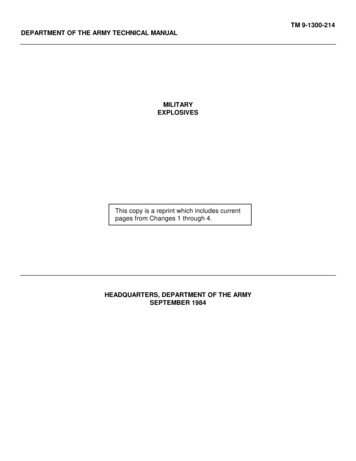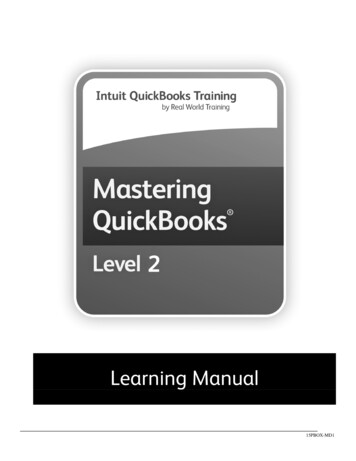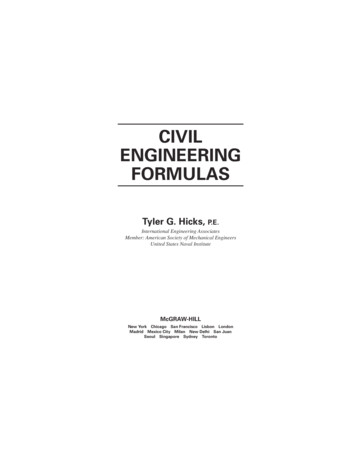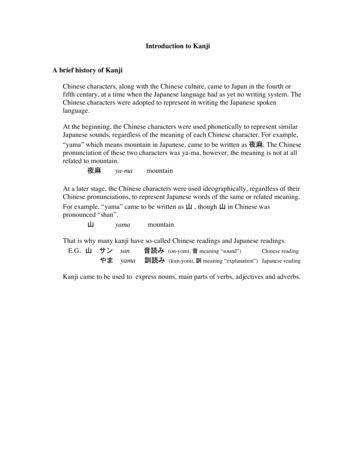
Transcription
TM 9-1300-214DEPARTMENT OF THE ARMY TECHNICAL MANUALMILITARYEXPLOSIVESThis copy is a reprint which includes currentpages from Changes 1 through 4.HEADQUARTERS, DEPARTMENT OF THE ARMYSEPTEMBER 1984
TM 9-1300-214C4Change ))No. 4)HEADQUARTERSDEPARTMENT OF THE ARMYWashington, D.C., 25 September 1990MILITARY EXPLOSIVESTM 9-1300-214, 20 Sep 84, is changed as follows:1. Remove old pages and insert new pages as indicated below. New or changed material is indicated by a vertical bar inthe margin of the page.Remove pagesInsert pagesA8-49 and 8-508-125 and 8-126A8-49 and 8-508-125 and 8-1262. File this change sheet in front of the publication for reference purposes.By Order of the Secretary of the Army:CARL E. VUONOGeneral, United States ArmyChief of StaffOfficial:THOMAS F. SIKORABrigadier General, United States ArmyThe Adjutant GeneralDistribution:To be distributed in accordance with DA Form 12-34-E, requirements for TM 9-1300-214.
TM 9-1300-214C3Change ))No. 3 )HEADQUARTERSDEPARTMENT OF THE ARMYWashington, D.C., 30 September 1988MILITARY EXPLOSIVESTM 9-1300-214, 20 Sep 84, is changed as follows:1. Remove old pages and insert new pages as indicated below. New or changed material is indicated by a vertical bar inthe margin of the page. Revised chapters are indicated by a vertical bar adjacent to the title.Remove pagesInsert pagesA pagei (ii blank)12-1 thru 12-30Index 1 and 2Index 5 thru 26A pagei (ii blank)12-1 thru 12-6Index 1 and 2Index 5 thru 262. File this change sheet in front of the publication for reference purposes.By Order of the Secretary of the Army:CARL E. VUONOGeneral United States ArmyChief of StaffOfficial:R.L. DILWORTHBrigadier General United States ArmyThe Adjutant GeneralDistribution:To be distributed in accordance with DA Form 34B-R.
TM 9-1300-214C2Change ))No. 2 )HEADQUARTERSDEPARTMENT OF THE ARMYWashington, D.C., 30 January 1987MILITARY EXPLOSIVESTM 9-1300-214, 20 Sep 84, is changed as follows:1. Remove old pages and insert new pages as indicated below. New or changed material is indicated by a vertical bar inthe margin of the page. Revised chapters are indicated by a vertical bar adjacent to the title.Remove pagesInsert pagesA pagei(ii blank)12-1 thru 12-49(12-50 blank)15-3 and 15-4Index 11 and Index 12Index 21 and Index 22A pagei(ii blank)12-1 thru12-3015-3 and 15-4Index 11 and Index 12Index 21 and Index 222. File this change sheet in front of the publication for reference purposes.By Order of the Secretary of the Army:JOHN A. WICKHAM, JR.General United States ArmyChief of StaffOfficial:R.L. DILWORTHBrigadier General United States ArmyThe Adjutant GeneralDistribution:To be distributed in accordance with DA Form 12-40A-R, General Information Applicable to all Organizations which havea Conventional Munitions Mission.
TM 9-1300-214C1Change ))No. 1 )HEADQUARTERSDEPARTMENT OF THE ARMYWashington, D.C., 30 November 1985MILITARY EXPLOSIVESTM 9-1300-214, 20 Sep 84, is changed as follows:1. Remove old pages and insert new pages as indicated below. New or changed material is indicated by a vertical bar inthe margin of the page.Remove pagesInsert pagesNone6-1 and 6-29-3 and 9-49-7 and 9-815-3 thru 15-6A page6-1 and 6-29-3 and 9-49-7 and 9-815-3 thru 15-62. File this change sheet in front of the publication for reference purposes.By Order of the Secretary of the Army:JOHN A. WICKIAM, JR.General, United States ArmyChief of StaffOfficial.MILDRED E. HEDBERGBrigadier General, United States ArmyThe Adjutant GeneralDistribution:To be distributed in accordance with DA Form 12-40A-R, General Information Applicable to all Organizations which havea Conventional Munitions Mission.
When applicable, insert latest change pages and dispose ofsuperseded pages in accordance with applicable regulations.LIST OF EFFECTIVE PAGESTOTAL NUMBER OF PAGES IN THIS PUBLICATION IS 361CONSISTING OF THE FOLLOWING:PageNo.CoverAiii blank1-11-2 blank2-1 thru 2-232-24 blank3-1 thru 3-53-6 blank4-1 thru 4-174-18 blank5-1 thru 5-106-16-2 thru 6-47-1 thru 7-208-1 thru 8-498-508-51 thru 8-1248-1258-126 thru 8-1358-136 blank9-1 thru 9-39-49-5 thru 9-79-89-9 thru 9-1210-1 thru 10-1310-14 blank11-1 thru 11-1711-18 blank12-1 thru 003*ChangeNo.12-6 blank13-1 thru 13-1113-12 blank14-1 thru 14-1514-16 blank15-1 and 15-215-3 and 15-415-515-615-7 thru 15-1515-16 blankA-1 thru A-13A-14 blankB-1 and B-2Index 1 and Index 2Index 3 and Index 4Index 5Index 6 and Index 7Index 8 and Index 9Index 10 and Index 11Index 12 thru Index 19Index 20Index 21Index 22Index 23Index 24 thru Index 26Authentication page*Zero indicates an original page.Change 4A000000201000003030303032030
*TM 9-1300-214Technical ManualHEADQUARTERSDEPARTMENT OF THE ARMYWashington, DC 20 September 1984No. 9-1300-214MILITARY EXPLOSIVESREPORTING OF ERRORSYou can help improve this manual. If you find any mistakes or if you know of a wayto improve the procedures, please let us know. Mail DA Form 2028 (RecommendedChanges to Publications and Blank Forms) or DA Form 2028-2 located in the back ofthis manual direct to: Commander, US Army Armament, Munitions and ChemicalCommand, ATTN: AMSMC-MAY-T(D), Picatinny Arsenal, NJ 07806-5000.A reply will be furnished to ENDIX AAPPENDIX BINDEX .ParagraphPageINTRODUCTION . 1-11-1HISTORICAL DEVELOPMENT OF ENERGETICMATERIAL . 2-12-1GENERAL CHARACTERISTICS AND CLASSIFICATION OFENERGETIC MATERIALS . 3-13-1CHEMISTRY AND PHYSICS OF ENERGETICMATERIALS . 4-14-1PROPERTIES AND TESTS OF EXPLOSIVES . 5-15-1PROPERTIES AND TESTS OF PROPELLANTS . 6-16-1UNITED STATES PRIMARY EXPLOSIVES . 7-17-1UNITED STATES BOOSTER AND SECONDARYEXPLOSIVES . 8-18-1UNITED STATES PROPELLANTS. 9-19-1UNITED STATES PYROTECHNICS .10-110-1FOREIGN ENERGETIC MATERIALS.11-111-1TOXICITY OF ENERGETIC MATERIALS .12-112-1DETECTION AND IDENTIFICATION OF ENERGETICMATERIALS .13-113-1PACKING, MARKING, STORAGE, AND SHIPMENT OFENERGETIC MATERIALS.14-114-1DISPOSAL, DESTRUCTION, DECONTAMINATION, ANDDEMILITARIZATION OF ENERGETICMATERIALS .15-115-1. A-1. B-1.Index 1*This manual supersedes TM 9-1300-214, 28 November 1967, including all changes.Change 3i (ii blank)
TM 9-1300-214CHAPTER 1INTRODUCTION1-1. Purpose. This manual is intended for use as atext for instruction or as a reference source in the fieldof energetic materials. Only the materials of interest inconventional armaments are covered; nucleararmaments are not.1-2. Scope. Chapter 2 is a history of the field ofenergetic materials. Chapter 3 divides the energeticmaterials field into three categories:explosives,propellants, and pyrotechnics. Chapter 4 discusses theprinciples of chemistry and physics pertinent to theenergetic materials field. Chapter 5 is a description ofthe tests used to evaluate explosives. Both mandatorysafety tests and tests used in the selection of particularcompounds among the many explosive compounds arecovered. Chapter 6 contains a description of the testsused to evaluate propellants. Chapter 7 presentsdetailed information about the compounds that are usedby the United States as initiating explosives.Adiscussion of priming compositions is also included.Chapter 8 presents detailed information about thecompounds that are used by the United States asbooster and secondary explosives. Chapter 9 providesa discussion of those mixtures of materials that are usedas propellants. Chapter 10 discusses the field ofpyrotechnics. Foreign energetic materials are coveredin Chapter 11. Safety and toxicity considerations arediscussed in Chapter 12. Basic methods used toidentify and detect energetic materials are presented inChapter 13. Chapter 14 presents information pertinentto the packing, marking, storing, and shipping ofenergetic materials. Chapter 15 discusses disposal,destruction, decontamination, and demilitarization ofenergetic materials. Pertinent data on explosives andpropellants are tabulated in Appendix A. Tables A-1through A-8 allow rapid comparison of the importantcharacteristics of the material. The bibliography iscontained in Appendix B. An index for all materialcovered, referencing both paragraph and page numbers,concludes the contents of this manual.1-1(1-2 blank)
TM 9-1300-214CHAPTER 2HISTORICAL DEVELOPMENT OF ENERGETIC MATERIAL2-1. Introduction.a. Purpose.This chapter describes thedevelopment of energetic material in chronologicalorder.b. Scope. This history is mainly concerned withmilitary applications of energetic material, howeversome important nonmilitary uses are also discussed.c. Relationship of Development to Science andTechnology. Developments in the energetic materialfield are generally the result of a close relationshipbetween basic research and technology. Advances inbasic research provide new materials and newapplications. The use of the new materials and newmethods of application, as well as ideas from otherfields, advance technology or even create newtechnology. The advancement of technology gives animpetus to further research. For example, the shapedcharge effect was discovered in 1888. Little use of theprinciple was made until World War II, whentechnological advances made the tank a major battleweapon. At the present time, significant progress isbeing made in lessening the effect of a shaped chargeon armor. This will require further development inenergetic materials and their applications to defeat thenewer types of armor.d. InterrelationshipAmongExplosives,Ammunition, and Weapons.(1) Explosives are the materials thatdetonate. They may be used independent of, or form apart of, ammunition.For military managementpurposes, the two are controlled as one category ofweapons or armaments.(2) Weapons are instruments of any kindused in fighting. We may consider weapons as the toolsused in warfare. The development of these tools is theart or science of weaponry. Weaponry includes use ofclubs, stones, slings, axes, spears, darts, javelins, bowsand arrows, shields, body armor, etc. for hunting andfighting. Later, siege weapons such as catapults andballista (the forerunners of cannon) were developed tohurl large stones and other missiles at fortifications.Better weapons created the need for a special group ofartisans called metalworkers and metallurgists. Themetalworkers began shaping the weapons from metals.The metallurgists practiced the art or science ofextracting metals from their ores, refining them, andpreparing them for use.e. Discoveries,Inventions,Developments.Historians often disagree as to who was the first todiscover, invent, develop, or use a new theory,characteristic, device, or material. Authenticating thisinformation is a difficult task, for the records andterminology used to record these facts may bemisleading. What has been published and used as anofficial source in subsequent documents may have beentaken from an unreliable source.The history ofenergetic materials is particularly full of such examples.For example, who invented black powder orgunpowder? And, when was gunpowder first used?Sometimes the answer is that several or many people ornations were all involved at the same time.2-2. Early Use of Flame, Incendiaries, and Smoke.a. Flame and Incendiaries.Flame andincendiaries are the oldest chemical weapons datingback to the caveman's use of flames and burning coalsto drive off animals and enemies. In Biblical times,armies attacking and defending fortified cities threwupon each other burning oils and flaming fireballsconsisting of resin and straw. In 424 BC, the Spartanssuccessfully employed a prototype of the flamethroweragainst a Greek fort in Delium. Attaching a pot filledwith burning pitch, coals, and sulfur to a hollow log, theyused bellows to blow a hot jet of flame which set fire tothe city walls and routed the defenders. Incendiarycompositions of pitch, sulfur, hemp or flax, and resinouswood were used in the Trojan Wars about 360 BC.Centuries later, the Romans used similar materials infire bombs or fire pots, which they catapulted over thewalls of besieged towns. To set fire to wooden fortsthey used hollow, perforated arrows filled with incendiarymaterials, which were ignited just before being shot.The most famous of the incendiary mixes was "GreekFire," which was prepared by Kallinikos of Heliopolis inSyria to enable the Byzantine fleet to defeat theCaliphate Navy in 668 AD. The exact formula for GreekFire is unknown. However, the formula is believed to bea mixture of sulfur, naptha, pitch, resin, and quicklime,which ignited and burned fiercely upon contact withwater. The Greek Fire was apparently forced by water,under high pressure, through tubes or siphons. Theviolent reactions and high pressure ejected the burningincendiary mixture toward the enemy ships. For thenext six centuries, the Byzantines used Greek Fire tothwart the Moslem and subsequent Russian sieges ofConstantinople. Chinese2-1
TM 9-1300-214Chinese about 1225 AD. Bacon mentioned in hiswritings that the ingredients of black powder were usedin firecrackers made in various countries of the world.manuscripts as early as 969 AD mention fire arrows, firelances, and incendiary "rockets." But with the exceptionof Greek Fire, such weapons had little impact on warfareuntil World War I.b. Smoke. While history tells us that screeningsmoke was employed in early conflicts, the results ofthese isolated incidents were always too uncertain tojustify the adoption of smoke as a recognized agent ofwarfare. In fact, prior to World War I dense clouds ofsmoke generated by the black powder used in battle hadbecome a definite nuisance. These clouds obscured thefield of vision, interfered with aiming and firing, andhampered the movement of troops. More recently,these very same characteristics have been exploitedtactically by the planned employment of screeningsmoke munitions.2-4. Introduction of Gunpowder In Europe.a. Invention of Guns and Gunpowder. The age ofgunpowder began early in the 14th century with theinvention of the gun, which consisted of a metal tubefrom which a projectile was discharged by the explosiveforce of black powder. Guns and gunpowder provided anew means of propelling stone, iron, or lead balls withgreater force than catapults or slings. The discovery ofthe usefulness of black powder for accomplishingmechanical work may be considered the real beginningof the history of explosives. When ignited by a torch, aloose charge of black powder above the borehole of agun served as a priming composition. A train of blackpowder in the borehole advanced the ignition to set offthe propellant charge of black powder in the gun tube.The Chinese and Europeans evidently became aware ofthis application of black powder about the same time.Because Chinese developments did not keep pace withthose in Europe, the Europeans have been credited withinventing and developing guns and gunpowder. Theearliest mention of black powder on military supply listswas in 1326 AD. Also at that time, a Latin manuscriptcalled "On the Duties of Kings," written by Walter deMilemete, King Edward Ill's chaplain, included the firstknown illustration of a cannon.b. Manufacture of Gunpowder. Roger Bacon'sblack powder recipe was not for gunpowder. Differentproportions of saltpeter, charcoal, and sulfur wererequired to propel missiles from the early cannon andfirearms. In the mid 12th century, John Arderne, anEnglishman, gave the proportions of saltpeter, charcoal,and sulfur as 6:2:1, the same as recommended byMarcus Graecus around 1275 and by Albertus Magnusin 1300. The Germans, who some scholars claiminvented gunpowder and guns around 1313 (i.e., thelegendary Berchtold Schwarz), were using a mixture of4:1:1 in 1350. The ingredients were ground, mixed, andused in a fine powder or meal. At first, the materialswere mixed in a mortar using a pestle operated by handand were later mixed by horse power.Later,improvements in machinery mixed gunpowder withrollers on a marble slab and with wooden stamps.Mixing black powder was considered a highly technicalart and a dangerous one too. Sometimes the finalmixing was done at the gun site to reduce the hazard ofstores exploding. Nevertheless,2-3. Invention of Fireworks and Black Powder.a. Fireworks. Fireworks are devices that producedisplays of lights, noise, or smoke by the combustion ofexplosive compositions. Fireworks are managed underthat group of ammunition designated as "pyrotechnics."Those who ply this art are called "artificers." Somehistorians credit the Chinese with being the first trueartificers. In the reign of Haiao Tsung of Nan Subng(1169-1189 AD), true fireworks made their debut. Theywere similar to those used today. The first fireworkswere made of incendiary materials with variouspowdered minerals added to color, or to increase thelight or smoke effect. Not until the invention of blackpowder were the artificers able to generate the displayswith which we have become familiar today, such asRoman candles, rockets, fire crackers, serpentines,whistles, and stars. The French, in particular, becamevery adept at civil pyrotechnics by the 17th and 18thcenturies. Civil pyrotechnics are generally limited tofireworks used for public display, signaling, or rescuing.b. Black Powder. Authorities differ upon the originof black powder accrediting in turn the Chinese, Hindus,and Arabs. In 1249 AD Roger Bacon, an English monk,recorded a formula for black powder saltpeter (7 parts),charcoal (4 parts), and sulfur (4 parts). Although Baconwas not the inventor, his were probably the first trulyscientific experiments with this explosive. Sulfur andcharcoal had been used in incendiary compositions formany centuries. Saltpeter (potassium nitrate) appearsin nature but requires refining to supply the properamount of oxygen to ignite the black powder mixture.Bacon's knowledge of purified saltpeter probably camefrom the Arabs who obtained this information from the2-2
TM 9-1300-214the records of towns and armies during the early days ofgunpowder contain many references to accidentalexplosions. Other mostly useless ingredients, such asamber, alcohol, camphor, wine, urine, arsenic, and salarmoniac, were added to the recipe to improve stability,reduce absorption of moisture, and to preventcrumbling. Depending on the weapon or the use, somecountries varied the proportions of saltpeter, charcoal,and sulfur. For example, the French at one time madesix different mixes one strong and one weak each forpistols, muskets, and cannons. Different mixes havebeen used for blasting, mining, and sporting weapons.In 1895, most countries, including the USA, adopted theEnglish standard 75: 15: 10 (saltpeter: charcoal:sulfur), which had been in effect since 1781. Thisstandard is generally used for all arms, the onlydifference being in the size of the grains.c. 1560.Linen or paper bags containinggunpowder were used for charging cannons.d. 1578. An instrument for testing gunpowder wasdevised by Bourne of England. Until then, the only testwas to burn a small quantity to see how much residuewould be left. The testing device consisted of a smallmetal cylinder with a heavy metal lid on a hinge. The lidwas prevented from falling by a ratchet, and the angle towhich the lid rose when powder was fired inside thecylinder measured the strength.e. 1588. Explosive shells were used at the siegeof Bergen op-Zoom and Wachtendonck, Holland by theDutch. The shells were made from hollow iron ballsfilled with gunpowder. The gunpowder was ignited by afuze consisting of a hollow tube filled with slow burningserpentine powder, and timed to burn 14 to 20 seconds,corresponding to ranges of 914 to 1830 meters (1000 to2000 yards) for mortar fire. The knowledge for makingthis fuze was brought to the Dutch by an Italian deserterfrom Parma.f. 1590.Cartridges with ball and powdercombined were introduced for small arms.g. 1602-1604. Fulminating gold, later used as apriming explosive, was invented by Johann Tholden, aDutch chemist in the employ of the British Navy.h. 1611-1632. An improved paper cartridge wasdeveloped during the rule of Swedish King GustavusAdolphus, thus increasing the rate of fire for firearmsused in the Thirty Years' War.i. 1613. Blasting powder is reported to have beenused in German mines to blast rocks. Less saltpeterand more charcoal and sulfur were used in blastingpowder than in gunpowder.j. 1627. An improved instrument for testing blackpowder was devised by Curtenbach. This consisted of aheavy conical shot, which rested on the mouth of asmall mortar and could travel vertically upwards along astretched wire provided with a series of catches to stopthe shot from falling.k. 1627. Black powder was used to blast ore in theroyal mines at Schemnitz, Hungary followingexperiments by a Hungarian engineer, Kaspar Weindl.Using black powder for this purpose was slow to beaccepted because saltpeter was expensive, boringinstruments were not available, and safety hazards frommine gases and cave-ins were increased.I. 1628. Gold fulminate priming explosives fortorpedoes were invented by J. Thollen for the BritishNavy.2-5. Developments Between the 15th and 18thCentury. The development of energetic materials from1400 to 1800 were restricted mainly to improvements inthe manufacture of black powder and relatedapplications. By 1400, iron cannons, bound by ironhoops to keep them from bursting, and iron cannon ballswere coming into use. At the end of the 14th century, ahand gun was invented that weighed 4.5 kilograms (10lbs) and fired lead shot. One man carried the gun,which was mounted on a stand and aimed at the enemy.This weapon evolved into the arquebus or harqebus, ahand gun with a bent stock and a forked staff to supportthe barrel while firing. A lit match or fuse of serpentineblack powder was used to ignite the propellant powdercharge through a touch hole in the breech (closed end)of the gun barrel.Other important events ordevelopments during this period are as follows:a. 1425. Corning, a new process for making blackpowder into grains instead of the finer serpentinegunpowder, was invented. Corning consisted of wettingblack powder to form a paste, which was then poundedinto a cake. The cake was broken into small lumps byhand and sifted. The resulting pieces, which were calledcorned powder, absorbed less moisture and were moresuitable for use in cannons than the serpentine powder.Flame from the priming powder was distributed moreefficiently by the larger grains. This resulted in a morecomplete explosion and reduced fouling.b. 1540. Standard gunpowder grain sizes forpistols, muskets, and cannons were adopted by theFrench. They discovered that less powder was neededto propel a projectile if the grain size was controlled. Byusing uniform, slow-burning grains they were able tocontrol the pressure of the explosion in the gun, andthereby reduce the hazard of blowing up the gun. Thisdiscovery also led to improvements in gun design.2-3
TM 9-1300-214over 350 years. The discovery of new materials or thepractical application of previously known materials (foexample, picric acid) greatly influenced the design andperformance of weapons and ammunition. In turn, therapid development of weapons and ammunition, and theincreased demands of new and expanding industriesfurther accelerated the search for more effective, lessexpensive materials. During the nineteenth century,more powerful propellants (such as smokeless powder),better primers, various boosters or detonators, and newhigh explosives were introduced. There were significantadvancements in the science and technology ofweapons and ammunition, too. Among these wereimproved explosive (Congreve) rockets (later adaptedfor signaling and illumination), rifled arms, revolvers,magazine-loading rifles, machine guns, revolvingturrets, armored naval vessels, percussion caps(encapsulated primers), metallic cartridges, time fuzesand impact fuzes for artillery shells, rifled breechloading field artillery, obturation devices, and spring andhydropneumatic recoil mechanisms for artillery. Modernmass production began when Samuel Colt, an Americangunsmith, first manufactured standard rifle and revolverparts. Mass production of small arms ammunitionbegan when G. Moore Peters used the first cartridgeloading machinery at his factory in Ohio. Nineteenthcentury developments of energetic materials follow.m. 1647. Testing the strength of gunpowder, byfiring a ball from a mortar and measuring the distancethe ball travelled, was proposed by Master-Gunner Nyein his "Art of Gunnery." This mortar test was adopted byFrance and other countries soon afterward.n. 1654. Ammonium nitrate was first prepared byJ. R. Glauber, a German chemist.o. 1679. Blasting powder was used on a largescale in the construction of the Mal pas Tunnel, Canalde Midi, France.p. 1684. Glazing process for gunpowder wasintroduced. Rough gunpowder corns were glazed bytumbling them in large wooden drums until the grainsurfaces were smooth. Graphite was added to coat thegrains. Glazed gunpowder was less hygroscopic andflowed more easily than the unglazed gunpowder.q. 1735. Antimony sulfide and arsenic sulfide wereused by Ruggieri of Italy in pyrotechnic mixtures forbrilliant fireworks displays at Versailles.r. 1738. The closed bomb for measuring thepressure generated by gunpowder fired in a closedvessel was designed by d'Antony of Italy.s. 1742. The ballistic pendulum, which determinedthe velocity of a projectile's impact by measuring therecoil of a struck pendulum, was invented by BenjaminRobins, an English mathematician. Robins showed thatair resistance on a moving projectile at high velocities isgreater than the resistance at low velocities. Robinsalso developed the first practical chronograph, aninstrument for measuring and recording short durationsof time, and improved on a closed bomb for testing thepower of an explosion.t. 1771. Picric acid was first prepared by PierreWoulfe, a French chemist, by treating silk with nitricacid. Picric acid is an aromatic nitro compound whichwas used as a yellow dye until its explosive propertieswere discovered in 1871.u. 1784-1788. Potassium chlorate was prepared inits pure state by Claude L. Berthollet, a French chemistwho discovered its detonating properties. His idea ofusing potassium chlorate instead of potassium nitrate inblack powder was abandoned after a disastrousexplosion during manufacture in 1788.Berthollet also prepared fulminating silver in 1788.v. 1784-1789. Compact black powder grains wereobtained by pressing the cakes with screw pressesbefore corning at Faversham, England.a. 1800. Mercury fulminate was discovered byEdward Howard, an English chemist, who described itsdetonating properties in a paper before the RoyalSociety.b. 1801. Fireworks formulas containing metal saltsand ammonium chloride were published by C. F.Ruggieri, an Italian artificer. These salts producedbrighter flames because volatile metal chlorides wereformed during the combustion reaction.c. 1807. The principle of using mercury fulminateas a primer was patented by Rev. Alexander J. Forsythof Aberdeenshire, Scotland.d. 1823. Chlorates, discovered by C. F. Bertholletin 1786, were first used in fireworks by John Cutbush, anEnglish artificer.e. 1825. Benzene, creosote, and naphthalenewere isolated from coal tar (obtained from bituminouscoal) by Rev. Dr. Clayton in England. Most of hisproducts were later nitrated to produce explosives, suchas trinitrobenzene and nitronaphthalenes.f. 1826.Aniline was first prepared byUnverdorben. Later, nitration of aniline resulted in thevery powerful explosive called tetranitroaniline.2-6. Nineteenth Century Development. Modernenergetic materials technology began with thenineteenth century. New energetic materials began todisplace the black powder formulas that had been thechoice for use in weapons, ammunition, and blasting for2-4
TM 9-1300-214n. 1846-1847. Nitroglycerin, an ester of glycerinand nitric acid, was invented by Asconio Sobrero, anItalian chemist. Because nitroglycerin is very sensitiveto slight shocks, commercial use was delayed until theinvention of dynamite and blasting gelatin. Nitroglycerinwas also used later to make smokeless powder.o. 1847.Mannitolhexanitrateorhexanitromannitol was first prepared by A. Sobrero, butthe explosive properties were not examined until 1878when N. K. Sokoloff of Russia investigated thesecharacteristics.p. 1847. Cyanuric triazide was first prepared byAuguste A. T. Cahours, a French chemist.q. 1850.
By Order of the Secretary of the Army: CARL E. VUONO General, United States Army Chief of Staff Official: THOMAS F. SIKORA Brigadier General, United States Army The Adjutant General Dis










